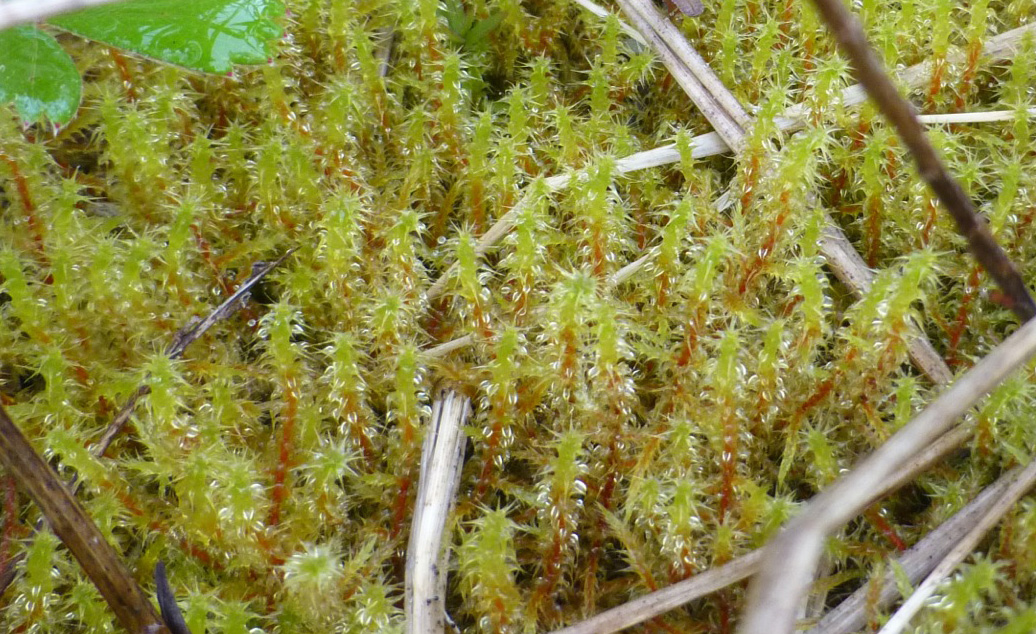Bent-leaf moss • Rhytidiadelphus squarrosus
Identification
This light green or yellowish-green moss has reddish stems. It is a large moss, forming 15 cm tall mats, and can be unbranched or irregularly branched with upright or arched main stems. Its heart-shaped leaves spread from the stem at right angles (squarrose); this gives the plant a bristly texture which appears star-like when shoots are viewed from above. A distinctive feature of this species the lack of pleating on its leaves - this, combined with the squarrose leaves and the unbranched or irregularly-branched growth, makes bent-leaf moss relatively easy to identify. It also lacks paraphyllia (small green filaments) along its stem. Sporophytes are uncommon.
Habitat & Range
Bent-leaf moss commonly grows among grass in disturbed habitats such as roadsides and lawns, where it is considered a weed. It also grows along streams and other open areas where moisture does not dissipate quickly. Its west coast range extends from Alaska to California; it is also found along the east coast of Canada and the United States. In more inland regions it is mostly found in mountains. It is a circumpolar species in the Northern Hemisphere.
Similar Species
Lanky moss (Rhytidiadelphus loreus) is pinnately branched and has pleated leaves. Goose-necked moss (Rhytidiadelphus triquetrus) is once-pinnately branched and has somewhat pleated leaves.
This light green or yellowish-green moss has reddish stems. It is a large moss, forming 15 cm tall mats, and can be unbranched or irregularly branched with upright or arched main stems. Its heart-shaped leaves spread from the stem at right angles (squarrose); this gives the plant a bristly texture which appears star-like when shoots are viewed from above. A distinctive feature of this species the lack of pleating on its leaves - this, combined with the squarrose leaves and the unbranched or irregularly-branched growth, makes bent-leaf moss relatively easy to identify. It also lacks paraphyllia (small green filaments) along its stem. Sporophytes are uncommon.
Habitat & Range
Bent-leaf moss commonly grows among grass in disturbed habitats such as roadsides and lawns, where it is considered a weed. It also grows along streams and other open areas where moisture does not dissipate quickly. Its west coast range extends from Alaska to California; it is also found along the east coast of Canada and the United States. In more inland regions it is mostly found in mountains. It is a circumpolar species in the Northern Hemisphere.
Similar Species
Lanky moss (Rhytidiadelphus loreus) is pinnately branched and has pleated leaves. Goose-necked moss (Rhytidiadelphus triquetrus) is once-pinnately branched and has somewhat pleated leaves.
References
Ellis, S. Rhytidiadelphus squarrosus (Hedw.) Warnst. Introduction to Bryophytes. Biology 321, Department of Biology, University of British Columbia, Vancouver. Accessed 07/01/2015.
Pojar, J. and MacKinnon, A. (1994). Plants of Coastal British Columbia. Vancouver, BC: Lone Pine Publishing. P. 472.
Rhytidiadelphus squarrosus (Hedw.) Warnst. In Klinkenberg, Brian. (Ed.). E-Flora BC: Electronic Atlas of the Plants of British Columbia. Lab for Advanced Spatial Analysis, Department of Geography, University of British Columbia, Vancouver. Accessed 07/01/2015.
Authors and editors of page
Kelly Fretwell, Ian Cruickshank, and Brian Starzomski (2015).
Ellis, S. Rhytidiadelphus squarrosus (Hedw.) Warnst. Introduction to Bryophytes. Biology 321, Department of Biology, University of British Columbia, Vancouver. Accessed 07/01/2015.
Pojar, J. and MacKinnon, A. (1994). Plants of Coastal British Columbia. Vancouver, BC: Lone Pine Publishing. P. 472.
Rhytidiadelphus squarrosus (Hedw.) Warnst. In Klinkenberg, Brian. (Ed.). E-Flora BC: Electronic Atlas of the Plants of British Columbia. Lab for Advanced Spatial Analysis, Department of Geography, University of British Columbia, Vancouver. Accessed 07/01/2015.
Authors and editors of page
Kelly Fretwell, Ian Cruickshank, and Brian Starzomski (2015).




